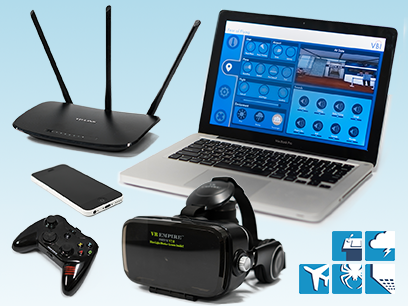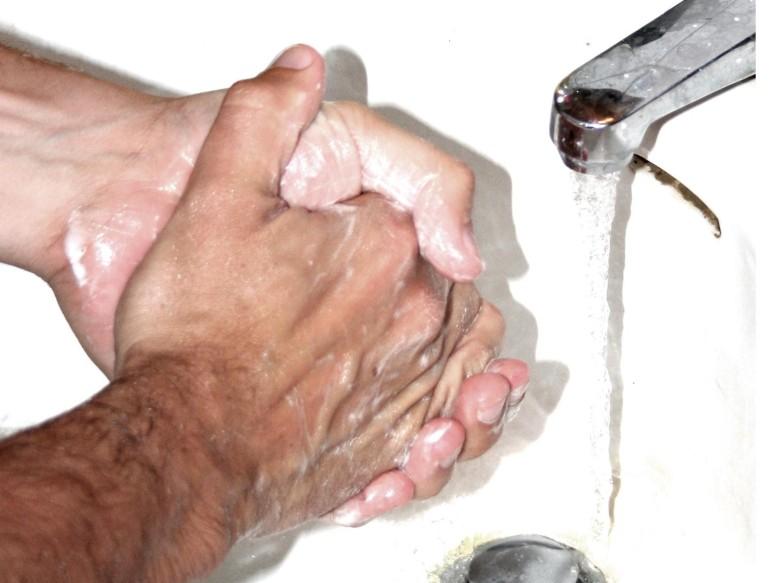Virtual reality will help get rid of the anxieties and fears that almost everyone has

Therapeutic system iPhone VR Therapy System, with the image of the available applications in the lower right corner. Illustration: Virtually Better, Inc.
The development of virtual reality began in the 50s of the last century, and in 1961, Philco Corporation developed the first Headsight virtual reality helmets for military use. Since then, VR technologies have somewhat improved their quality indicators, and now they are beginning to be used not only in military affairs, but also in other areas. For example, for the treatment of mental disorders. Specialists from Harvard University have published a review article , which examines the effectiveness of modern VR methods for the treatment of mental diseases, and especially - anxiety neuroses and phobias.
Anxiety neuroses (anxiety disorders) - a real scourge of our time. Because of them, people absolutely can not relax, live happily and enjoy life. The main symptom is increased general anxiety. Often there may be a fear of illness or accident that extends to oneself and / or to loved ones, various disturbances and forebodings. It is more common in women and in many cases is associated with chronic everyday stress.
Other symptoms - the need for movement, or speech anxiety, often unaware, fear, depression, obsessive thoughts, hypochondriacal fears, sleep disorders, depersonalization. When depersonalization own actions are perceived as if from the outside and are accompanied by a feeling of inability to control them. Often accompanied by derealization, when the world around us is perceived as unreal or distant, devoid of its colors. According to the doctors, the reasons for this condition are long-term mental overstrain or short in frequency but intense stress.
')
Virtual reality applications are especially useful in treating specific phobias, because they help a person to gradually plunge into the world of their fears, at the same time realizing the unreality of what is happening, but at the same time getting rid of mental disorder.
For realism of the transmitted sensations, therapeutic applications of virtual reality use VR helmets, gloves, synthesized sounds and vibro-tactical platforms. All this allows you to actively explore the virtual world, and in some cases and interact with it.

Frequent hand washing is a common obsessive action in obsessive-compulsive disorder sufferers.
Harvard scientists note that virtual reality is potentially a very powerful and useful tool for the psychiatric community, because the tests are conducted in a controlled environment. They can be repeated exactly or modified, carefully studying the effect. They list the results of several experiments in which VR was used to treat the following disorders:
- Specific fears of specific objects and situations : fear of height, flight, animals, needles, blood, and so on. The most well-researched is the treatment with the help of VR of fear of flying: here two studies have been conducted. They showed that after the treatment, the number of patients who bought tickets for airplanes increased and flew away. In general, VR together with cognitive-behavioral therapy (CPT) shows a better result than just CPT.
- Social phobia This is a mental state when a person experiences anxiety in social relations - for example, before a public appearance or before meeting new people. Here, VR applications showed the same efficacy as CPT, and the effect of treatment persisted after a year.
- Posttraumatic stress disorder . Several studies have shown a positive effect of treatment with VR: the effect is from moderate to very good. The experiments were set up to help the victims after the terrorist attack at the World Trade Center - for them the treatment was very effective. To the veterans of the Vietnam War, the help of virtual reality did not really help, but there was too little sampling. But the experiments on the participants of the hostilities and active military personnel demonstrated the real benefits of VR.
- Panic disorder and agoraphobia : a sudden influx of anxiety (panic attack) with psychological (heartbeat, sweating, lack of air) and cognitive (loss of concentration, fear or thoughts of death) that leads to the avoidance of certain places or situations (often tunnels, parking lots) , city squares, highway). Some experiments have shown that VR has the same positive effect as traditional exposure therapy. In other cases, VR technology was even more efficient, taking less time.
- General anxiety disorder . In one of the small experiments to measure daily stress levels, some of the 20 patients wore biosensors, and the VR sessions taught the patients to relax. There was no significant difference in results with the control group.
- Obsessive compulsive disorder (OCD) - intrusive, interfering or frightening thoughts (so-called obsessions). A person tries to get rid of them with the help of equally obsessive and tedious actions (compulsions) - for example, constantly washing my hands. In this area, the effectiveness of treatment using VR has not yet been evaluated, there were only two studies on the detection of OCD using VR.
- Schizophrenia - there is no reliable data yet, only the first studies of the use of VR in the treatment of schizophrenia were conducted, but they gave promising results.
- Acute and chronic pain . An initial experiment was conducted on a small group of four patients with burns. It turned out that the subjective assessment of pain is lower in patients who have undergone VR therapy. Another experience on a cancer patient confirmed that while in virtual reality, the suffering during the passage of painful procedures is reduced. Comparative testing of painkillers in combination with VR also confirmed that this method is more effective than conventional painkillers.
Researchers also mention experiments in the treatment of autism, addictions and various forms of eating disorders.
The first scientific article on the use of virtual reality in medicine was published in 1995. For two decades, a sufficient scientific base has been gathered to talk confidently about the good prospects for using VR for treating various mental disorders, phobias, anxiety disorders and other mental illnesses.
The scientific article was published in the May / June issue of the Harvard Review of Psychiatry for 2017 (doi: 10.1097 / HRP.0000000000000138).
Source: https://habr.com/ru/post/403819/
All Articles